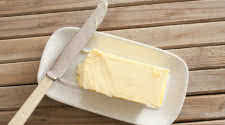The Role of Fats in Nutrition and Physical Fitness Goals

Smart Nutrition leads to Smart Success Paths
Nowadays it seems as if everyone is trying to reduce his or her fat intake, and there are plenty of new products to help in that effort. There's nonfat salad dressing, nonfat yogurt and nonfat
cottage cheese, as well as scores of other reduced-calorie foods on the supermarket shelves, These hems go a long way toward helping you cut back on the amount of fat you eat, and for the
average American who consumes more than 40 percent of his or her calories as fat they are welcome indeed.
Sometimes, however, hardcore bodybuilders feel that if less fat is good, no fat must be even better. They try to cut out all types of fat, restricting their protein sources to egg whites, fish
and nonfat dairy products in the hope that by eliminating every gram of fat from their diets, they'll lose all of their bodyfat. Unfortunately, it's not that simple-and it can be very unhealthy.
Most naturally occurring dietary fat is made up of molecules that consist of three fatty-acid chains linked to a glycerol molecule, which is why they're called triglycerides. The characteristics
of each of these three fatty-acid chains determine what the resulting fat will be. Fatty-acid chains fall into one of three types-saturated, monounsaturated and polyunsaturated-and the difference
between them lies in their chemical compositions. All fats are combinations of carbon, oxygen and hydrogen atoms that are linked together in a variety of ways.
When these atoms are linked so that pairs of hydrogen atoms are bonded to all the available sites on the carbon atoms, the fatty acid is said to be saturated with hydrogen atoms. Saturated fats,
such as butter and lard, are always solid at room temperature. Monounsaturated fats, as their name implies, have one pair of hydrogen atoms that is not bonded in this way and so are not fully
saturated. Polyunsaturated fats are even more unsaturated than the monounsaturated variety. Exam- pies of fats that are monounsaturated include avocado, olive and peanut oils, while corn, soybean
and safflower oils are polyunsaturated fats. Polyunsaturated fats are thinner liquids at room temperature than monounsaturated fats.
The more saturated the fat, the greater the risk of artherosclerosis and heart disease when you eat it. Fat actually has a number of vital functions in your body. You need it to absorb the essential
vitamins A, D, F and K. These vitamins are called fat- soluble, which means that they can only be assimilated in the presence of fat. For example, fat is required to produce vitamin A from carotene
and to absorb vitamin D so it can carry calcium to the teeth and bones. Fat also contains the essential nutrients linoleic and linolenic acid, which like the essential amino acids cannot be produced
by the body and must be supplied in the diet. Linoleic acid assists in the growth process, and deficiencies in these essential fatty acids can actually stunt the growth of children and lead to dry,
rough or flaky skin in adults.
Nevertheless, I'm not suggesting that you gorge yourself on pizza in the name of a balanced diet. While it's necessary to consume some fat to absorb the fat-soluble vitamins and to obtain the essential
linoleic and linolenic acids, you can get your daily requirement from a diet that contains only 20 grams of fat. Although this is far less than most people eat, it's more than some bodybuilders allow
themselves, especially during precontest dieting. The resulting deficiency can lead to health problems and submaximal athletic performance, so be careful not to overdo a good thing.
Maintain a diet of 10 to 15 percent fat during the training season, dropping to around 5 percent of your reduced daily calories during your contest-preparation period. While you can go for short periods
without eating fat before you develop linoleic and linolenic acid deficiencies, it's always wise to take in your 20 grams.
Some bodybuilders, in fact, are now using medium-chain triglyceride, or MCT, oil before contests to maintain their caloric intake while severely restricting their carbohydrate consumption. This, they
believe gives them the advantage of making their muscles look sharper because of the fact that carbohydrate foods contain water. Yet while MCT oil is more easily digested, absorbed and metabolized by
the body than animal and vegetable fat, it's still 100 percent fat except for the water, emulsifiers and flavorings that make it drinkable. So don't get carried away with MCTs.
Stay away from saturated fats as much as possible. Restrict your saturated-fat consumption to 20 percent of your total fat calories, or 2 to 3 percent of your total daily calories. While most all fatty
products contain a mixture of saturated and unsaturated fats, you can minimize your exposure to saturated fat by eating mostly fish, chicken, turkey and egg whites for your protein sources. This will
keep your total fat intake down as well. Reduce your beef, salmon and egg yolk consumption to a minimum, and when you do eat beef buy a very lean cut and trim away all the visible fat.
Also, throw out that butter dish and keep on driving past those fast-food restaurants. You should get your dietary requirement of fatty acids from good food, not from junk.